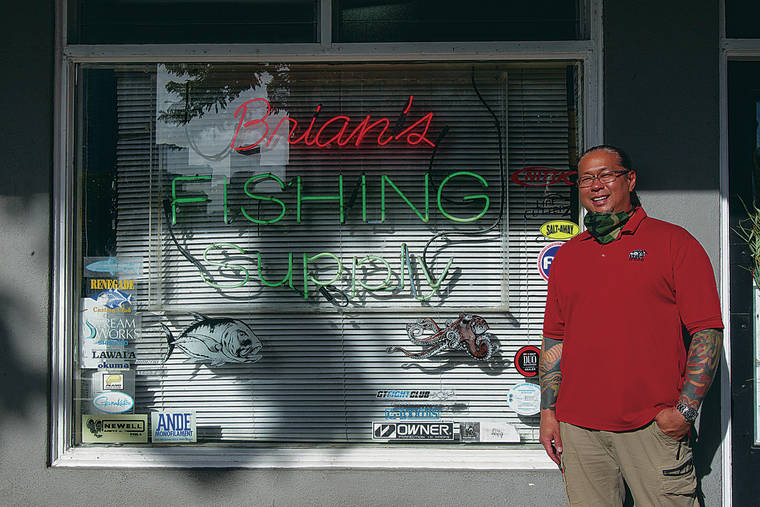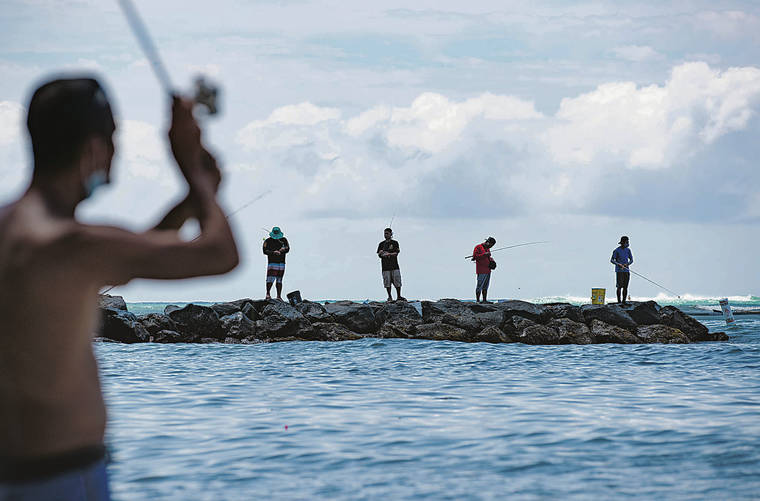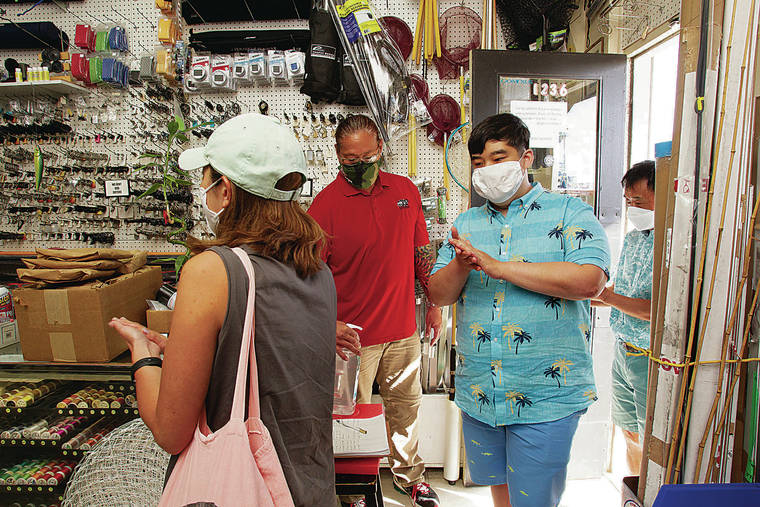Noncommercial fishing is booming in Hawaii during pandemic

CINDY ELLEN RUSSELL / CRUSSELL@STARADVERTISER.COM
Noncommercial fishing has increased during the pandemic, keeping fishing supply stores busy. Brent Young owns Brian’s Fishing Supply on South King Street.

CINDY ELLEN RUSSELL / CRUSSELL@STARADVERTISER.COM
Recreational fishing has seen a resurgence of popularity with the impact of COVID-19 restrictions. People fished for halalu that were schooling at Kaimana Beach in mid-September.

CINDY ELLEN RUSSELL / CRUSSELL@STARADVERTISER.COM
Customers sanitized their hands last month as they entered Brian’s Fishing Supply on South King Street. Pictured are Kanako Kang, left, store owner Brent Young, Sam Kang and James Kang.



Noncommercial fishing in Hawaii has been booming since the start of the COVID-19 pandemic, and many have turned to it out of necessity, according to fishing supply store personnel.
Since the novel coronavirus Opens in a new tab made its way to Hawaii in March, Brent Young, owner of Brian’s Fishing Supply in Honolulu, has observed more interest in fishing. Some of his customers are new fishers who want to learn, and others are seniors who haven’t fished in decades, but have had more time to do so.
“There’s no sports, there’s nothing to watch, there’s nothing to do. So they come back and they just want to fish,” Young said.
At times he’s had trouble keeping up with demand for fishing supplies. He had to install racks to a previously empty part of a wall in his store to make sure he had enough supplies, such as hooks, tackle and reel, available for customers.
And while many of them are looking to fish just as a hobby, Young has also noticed more customers who are out of work and need to fish.
“We’ve had a lot … of people come in to say they catch the food because they’re not working, and they’ve been very thankful that we’ve been open,” he said.
Don't miss out on what's happening!
Stay in touch with breaking news, as it happens, conveniently in your email inbox. It's FREE!
Young’s experiences align with those at other supply shops and, along with limited available data, reveal the importance of noncommercial fishing in Hawaii and how people have turned to it since the onset of the COVID-19 outbreak.
“I’ve been so busy,” said Matthew Uza, fishing manager at West Marine, on Nimitz Highway. “My shelves were empty for two months.”
Uza observed a $200,000 increase in sales in 2020 over 2019 and, like Young, said many customers come to the store out of necessity.
“People have to feed their families. I’m talking to a lot of these customers. They go, ‘It’s too expensive out there for food,’” Uza said. “They are literally having to catch food to survive, some of these people.”
On Hawaii island, Avery Berido, an employee at J Hara Store in Kurtistown, said as much.
“We get a lot of both. People who do like to fish have more time to fish, and other people (fish) especially because they have to supplement their food supply,” he said.
Using the ocean, for commercial or noncommercial reasons, is crucial to Hawaii’s residents and economy. Fishing for food — in particular to eat at home or share with friends and family — was indicated as important to 66% of noncommercial fishers Opens in a new tab recently surveyed by NOAA, and 36% said their catch was “extremely or very important to their regular diet.”
And considering Hawaii’s recent increase in its unemployment rate Opens in a new tab and projected jump in food insecurity rate Opens in a new tab — both consequences of COVID-19, and both among the worst in the nation — it’s not surprising to see a growth in noncommercial fishing.
Data from the National Oceanic and Atmospheric Administration’s Marine Recreational Information Program revealed that growth.
Noncommercial shoreline fishing “effort,” defined for MRIP as fishing trips by individual fishers, roughly doubled between March and August. Fishing trips almost tripled for boats and private charters.
One source of MRIP data is Hawaii Marine Recreational Fishing Surveys, conducted by personnel from the state’s Department of Land and Natural Resources’ Division of Aquatic Resources.
“We saw a pretty large spike, just by driving around and observing how many people are out, which basically reflects how (important) … shoreline fisheries are in the perspective of food security in the islands,” Tom Ogawa, survey manager for DAR, said.
Ogawa and his team gather data for HMRFS at public points of entry, such as boat ramps, piers and beaches, where they survey fishers.
But despite the available data for noncommercial fishing, there still isn’t a clear statistical picture of how it’s changed, because there are no thorough record-keeping systems in Hawaii.
Hawaii is the only coastal state that doesn’t require fishers to have a noncommercial marine fishing license, which could provide information about how many noncommercial fishers there are in Hawaii and how many fish they’re taking from the ocean.
As a result, most of the data on noncommercial fishing is provided voluntarily by fishers, as is the case for MRIP databases.
Other, smaller data collection efforts have helped demonstrate the significance of noncommercial fishing.
Early in the coronavirus outbreak, Matt Ramsey and other fishers with professional experience in fisheries management created a Facebook page called Hawaii Fishers Feeding Families Opens in a new tab, where fishers are asked to post photos of their catch, how many pounds of fish they caught and how many people they helped feed.
Ramsey posted Dec. 3 that since April 15, fishers caught and reported more than 11,200 pounds of fish, which helped feed more than 11,700 people across the state.
Most of that catch was on Oahu, where 6,000 pounds of fish were caught and more than 9,500 people were fed. It was followed by Hawaii island, where about 3,000 pounds of fish fed more than 1,000 people.
Since the group has only about 2,300 members, it represents just a “tiny fraction” of the catch by local noncommercial fishers.
Ramsey said the effort was a response to early coronavirus orders on the state and city levels that threatened beach access and fishing activity.
“What wasn’t being discussed was the impact beyond stopping COVID,” he said. “You’re cutting off … a supply chain, essentially, to families and to communities by shutting off fishing, and that’s part of the reason a lot of us got together and said, ‘Is anybody looking into this? Is anybody studying this? Is anybody tracking the data so decision-makers understand the ramifications of these actions?’”
About nine months since starting the Facebook page, Ramsey said, the “amount of catch and the amount of people fed with our local fisheries is kind of eye-opening to a lot of people.”
Michael McCloskey, vice principal at Holualoa Elementary School, has posted on Hawaii Fishers Feeding Families and kept or shared between 80 and 100 pounds of fish that he caught in 2020 — more than any other year he’s been fishing.
“I almost feel like there was something kicked in by COVID and by the whole pandemic that sort of … triggered some instinctive response, as goofy as that sounds,” he said.
McCloskey was able to keep his job despite the impacts of the coronavirus and does not rely on fishing for his meals, but he’s become more aware that many people do.
A cellphone application, Lokahi Fishing, has been developed with a goal similar to Hawaii Fishers Feeding Families, but it also holds a variety of minitournaments to encourage fishers to report catch information.
The various data collection efforts help fill gaps in information about noncommercial fishing in Hawaii, but they haven’t been able to fully cover the potential data that would come from a registry, permit or license system.
Voluntary mail surveys and on-site interviews to acquire data have led to small sample sizes and “questionable” results, said Ed Watamura, who represents Hawaii as a vice chairman of the Western Pacific Regional Fishery Management Council.
Estimates for the number of Hawaii noncommercial fishers have varied significantly, as demonstrated by 2006 surveys by the U.S. Fish and Wildlife Services and MRIP that reported 154,000 and nearly 396,000 fishers, respectively, in the state at the time.
Better data would help policymakers make better-informed decisions about Hawaii’s fisheries, such as annual catch limits, that are meant to ensure the sustainability of Hawaii’s fisheries.
“It’s a big black hole that we’re trying to fill, because without that knowledge it makes it a lot more difficult to manage the fisheries,” Watamura said. “You know that there’s a lot more recreational, noncommercial fishers than commercial fishers. … The number of noncommercial fishers could be large enough to affect how much fish is being caught.”
Introducing a mandatory license for noncommercial fishers has been a years-long struggle in Hawaii. State and federal governments have explained the utility of a licensing system, but many fishers across the state are still wary, often because there’s a lack of detail of what that system might look like.
They question where the money generated from license fees will go as well as the possible impacts to cultural practices, especially those by Native Hawaiians, that would be imposed by licensing. Some are also taken aback by the idea that they have to pay to fish — an activity that has been free for generations.
A licensing system would have to pass through the state Legislature, and Watamura said past efforts have been largely unsuccessful.
Watamura is in favor of mandatory but free registration in Hawaii. It could serve as a first step to a license and reporting system while also providing some information about the noncommercial fishing “universe.”



